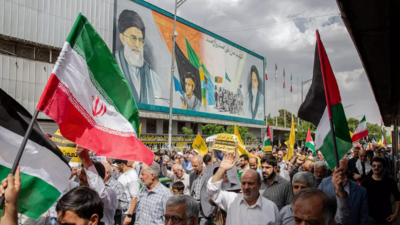7 years after pulling out, why is Donald Trump re-engaging Iran on nuclear deal,
US President Donald Trump announced on Monday, April 7, 2025, that Washington and Tehran would begin talks over Iran’s nuclear programme in Oman. Oman has acted as a mediator between the West and Tehran in the past. The two countries met in Muscat on Saturday, April 12, to explore the possibility of a new nuclear agreement.
Iranian state television said on Saturday that Iran and the United States will hold another round of talks next week regarding Tehran’s nuclear program. This came at the end of their first meeting since Donald Trump returned as president. According to Iranian state TV, US Mideast envoy Steve Witkoff and Iranian Foreign Minister Abbas Araghchi “briefly spoke” with each other — the first direct contact between the two sides since the Obama administration. Iranian state media mentioned the face-to-face conversation, indicating the talks were proceeding in a positive direction.
The White House issued a statement on Saturday afternoon saying the discussions were “very positive and constructive,” but also noted that the issues involved “are very complicated.”
“Special Envoy Witkoff’s direct communication today was a step forward in achieving a mutually beneficial outcome,” the White House said.
Both the Iranian and American sides said the next round of talks will take place on Saturday, April 19.
In 2018, President Trump withdrew the US from an earlier nuclear deal involving Iran and other world powers and reimposed economic sanctions. This move was strongly opposed by Iran.
President Trump has also said that military action is possible if the talks do not lead to an agreement.
Why is Iran not allowed to possess nuclear weapons?
Iran is not allowed to have nuclear weapons because it is a member of the Nuclear Non-Proliferation Treaty (NPT), which it signed along with most other countries. This agreement allows countries to use nuclear technology only for peaceful purposes, like energy, medicine, and agriculture. It strictly prohibits the development of nuclear weapons.
Although Iran says its nuclear programme is only for civilian use, many countries and the International Atomic Energy Agency (IAEA) are not fully convinced. Concerns grew in 2002 when Iran was discovered to have secret nuclear facilities, which violated the NPT. This led to suspicion that Iran might be working toward building nuclear weapons, even though it continues to deny those claims.
Moreover, countries like Israel, Saudi Arabia, and the United States worry that if Iran gets nuclear weapons, it could lead to a nuclear arms race in the Middle East and, consequentially, more instability in the already turmoiled region.
The US and its allies also see Iran as a threat because of its support for groups like Hezbollah and its opposition to Western influence in the region. Giving Iran access to nuclear weapons could make it harder to contain its regional power.
What was 2015 Iran nuclear deal?
The 2015 nuclear deal, officially called the Joint Comprehensive Plan of Action (JCPOA), was an agreement between Iran and six world powers—the United States, United Kingdom, France, Russia, China, and Germany—aimed at preventing Iran from developing nuclear weapons.
Under the deal, Iran agreed to limit its nuclear programme by reducing its stockpile of enriched uranium, cutting the number of centrifuges, and allowing regular inspections by the International Atomic Energy Agency (IAEA).
In return, international sanctions on Iran were lifted, helping its economy and giving it access to global markets. However, in 2018, US President Donald Trump withdrew from the deal and reinstated sanctions, after which Iran began breaching some of the agreement’s terms.
Iran’s nuclear progress since 2015 deal collapsed
Since the United States left the nuclear agreement known as the Joint Comprehensive Plan of Action (JCPOA) in 2018 and brought back sanctions, Iran has responded by not following key parts of the deal.
It has set up thousands of advanced centrifuges to enrich uranium, which the JCPOA had banned. To make nuclear weapons, uranium needs to be enriched to 90 per cent purity. Under the JCPOA, Iran was only allowed to keep up to 300kg of uranium enriched to 3.67 per cent , which is suitable for peaceful uses like energy and research.
However, by March 2025, the International Atomic Energy Agency (IAEA) said Iran had around 275kg of uranium enriched to 60 per cent. If enriched further, that amount could possibly be enough to make about six nuclear weapons. US officials believe Iran could produce enough…
Read More: 7 years after pulling out, why is Donald Trump re-engaging Iran on nuclear deal,


